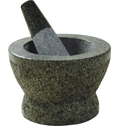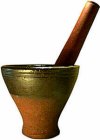
|
||||||||||||
The Mortar and Pestle in Thai CuisineWhy Do I Need a Mortar and Pestle?Excerpt from the cookbook 'Dancing Shrimp' by Kasma Loha-unchit.
To crush herbs, a mortar and pestle set is essential. In Thailand, there are several different kinds suited for particular purposes. For making curry pastes, a heavy stone mortar and pestle, carved out of granite, is the most efficient; it can reduce fibrous herbs and hard seeds in no time. The pestle and the inside surface of the mortar are polished smooth and are not rough, coarse or porous like the kind used in Mexican cooking. Very dense and heavy, they do not chip and last for years, even when subjected to vigorous pounding daily. Two types of mortar and pestles: Look for this dark-gray, stone mortar and pestle set in a Thai or Southeast Asian market. It is available in small, medium, and large sizes and costs about sixteen to twenty-five dollars. Buy the largest size, since you can use it for big as well as small jobs. It also enables you to pound more vigorously without worrying about bits and pieces of herbs spilling all over your work area.
The dark brown mortar comes in two different shapes - one deeper and more bowl-shaped, and the other with a noticeable molded-in stand and a wider, denser rim around the top. Because both are tall and deep, they keep the juice from the wet ingredients from splattering all over the place and, when you've finished crushing them, the lime juice, fish sauce, sugar and whatever remaining sauce ingredients can be added right into the mortar and stirred with the pestle until the sauce is well blended.
When making a curry paste in Thailand, all the ingredients are pounded together all at once in the mortar. Often, the softer and wetter ingredients like garlic and shallots are placed in whole as they mash up relatively easily. Coarse salt crystals provide some abrasion to reduce the harder and more fibrous herbs and spices, as well as release their flavors. The pounding goes on until everything in the mortar is mashed into paste and is no longer distinguishable. This can take a long time for someone inexperienced in mortar and pestle techniques. Shortcuts: For faster results without compromising flavor, chop or mince the ingredients ahead of time. This is where an electric chopper or processor can help out. (Lemon grass should be trimmed and sliced with a sharp knife into very thin rounds to break up the fiber that runs lengthwise.) Then, work one ingredient at a time with the mortar and pestle, starting with the dry spices. They are easily pulverized with a rolling motion of the pestle around the bottom and sides of the mortar while its surface is still dry. The dry ingredients, of course, may be ground ahead of time in a clean coffee grinder designated solely for spice-grinding. However, when grinding just a small quantity in the grinder, the spices often do not get very fine and need to be further reduced in the mortar to a fine powder. Method: Remove the ground spices from the mortar before proceeding with the most fibrous of the herbs. Pound one ingredient at a time, a small amount at a time, moving from the firmest and most fibrous to the softest and wettest. When each is done, remove from mortar before proceeding with the next. Herbs reduce more quickly when pounded with a sturdy, straight up-and-down motion. Develop a comfortably paced rhythm like you are beating on a drum - one that is not too fast as to tire the muscles in your arms quickly, but with enough strength so that the herbs do get crushed. Move the herbs around with the pestle so that a single layer is pounded at a time to maximize the efficiency of the hard pestle beating against the hard surface of the mortar. When they are reduced, push them aside and move uncrushed pieces to the center to be worked, and so on. Just because the mortar is large doesn't mean that you can pound and reduce a lot of herbs at a time. For fibrous herbs, too thick a bed of them can actually take longer and require more energy from you to reduce, as the pieces cushion one another. For quicker results, pound a small amount at a time, removing the crushed herbs before adding more to be crushed. When all the ingredients have been reduced, combine them and pound together until they become a uniform, well-blended paste. Besides the two types of mortar and pestle mentioned, I have a small, carved stone set that I use only for quick grinding of small, dry seeds, such as coriander and cumin. It works much better than the coffee grinder for pulverizing small quantities. Simply roll the pestle around the mortar, applying enough pressure to crush the seeds into powder. The small, Japanese-style, terra-cotta bowl with ridges inside, which comes with a wooden pestle, serves the same purpose, and is not meant to be used for reducing fibrous herbs to paste. Dancing Shrimp, Favorite Thai Recipes for Seafood by Kasma Loha-unchit. © 2000 Simon and Schuster.
We would love to hear your comments so feel free to share your thoughts with us. |
||||||||||||



